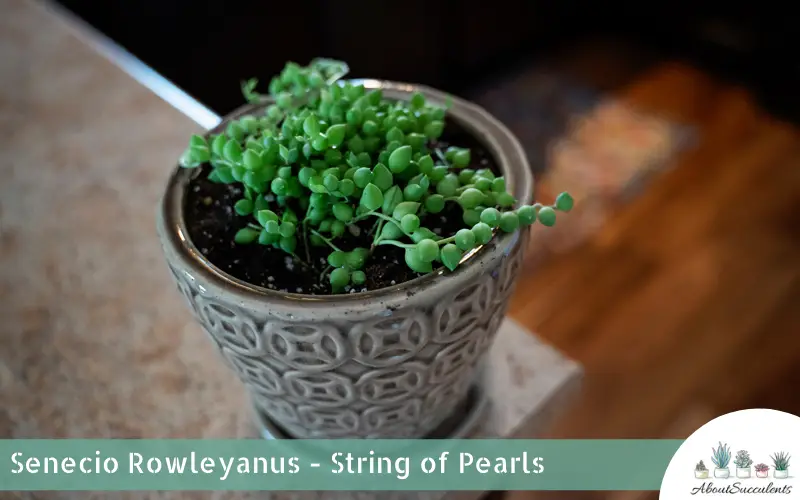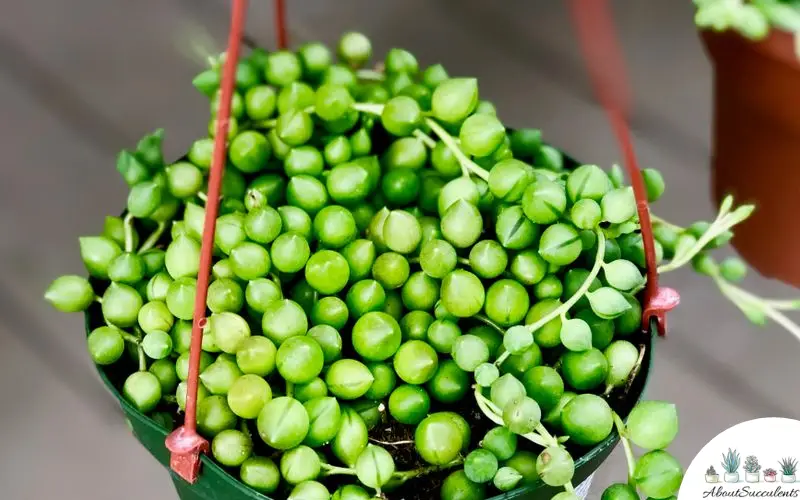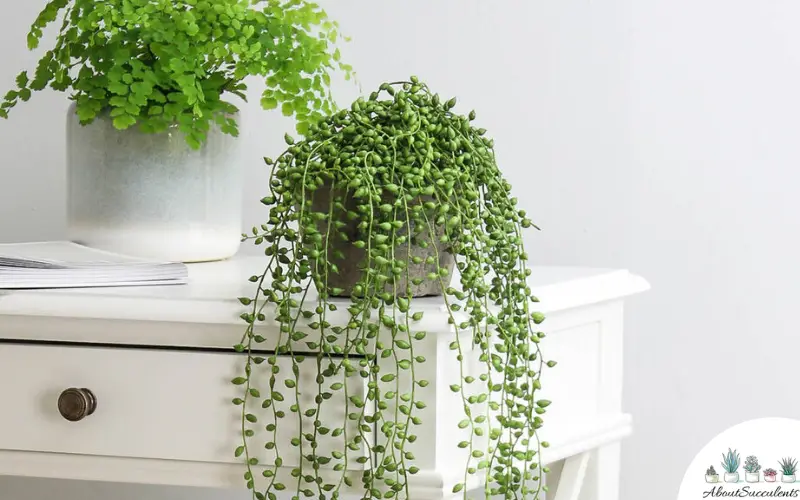
Senecio rowleyanus is an elegant succulent. It makes a perfect hanging garden plant. With its green, round leaves trailing down long, slender stems, Senecio rowleyanus creates an impression of a garden adorned by its other name – “String of Pearls”.
The greenish color gives String of Pearls the look of peas which are approximately ¼” in diameter. The leaves have small pointed tips at their ends plus a thin strip of dark green coloring along its side.
It can be said that Senecio rowleyanus is a marvel of nature’s engineering. The round shape of its leaf reduces surface area that is exposed to the dry air of the desert and prevents water loss. In addition, the shape of the leaf has been found to improve the occurrence of photosynthesis.
You will see a dark, somewhat translucent tissue on the side of Senecio rowleyanus’ leaf. This substance allows light to penetrate the leaf more effectively and encourage photosynthesis to take place.
Senecio rowleyanus, when allowed to trail, will reach a length of 3-feet or 90cm. Cut the stems if they are starting to look straggly.
String of Pearls comes from the Asteraceae family and is native to South Africa and Southern Namibia. The succulent was named after the British botanist who discovered it – Gordon Rowley.
General Information:
Also known as: String of Pearls
Plant Family: Asteraceae
Origin: South Africa and Southern Namibia
Height: 3-feet or 90cm
Exposure: Partial to light sunlight up to 3 hours per day
Water Needs: Water only when soil is dry to the touch, little watering during the winter months.
Soil Type: Cactus mix combined with an equal part of an inorganic material such as sharp sand, poultry grit, pumice, or small pea gravel.
Soil pH: Neutral (6.6 to 7.5 pH)
Tolerance: Drought

How to Grow and Care for Senecio Rowleyanus – String of Pearls
Senecio rowleyanus is a prolific grower. Plant it in a hanging basket and watch it grow rapidly; cascading down the side of the pot.
Senecio rowleyanus can also be grown in a flat dish to allow it to maintain the trailing growth it is known for in South Africa.
1. Sunlight
Senecio rowleyanus is not a cold-hardy plant. It thrives in a zone 10 environment where the temperature is a Minimum 30° F or -1° C.
String of Pearls will grow better under partial or light shade where it receives 2 to 3 hours of direct sunlight.
If grown indoors, place String of Pearls in an area where it can receive partial sunlight.
2. Watering
Senecio rowleyanus is more sensitive to overwatering compared to other types of succulent plants.
If you give it more water than it needs, the “pearls” may burst. Also, it will lead to overwatering which will cause the roots to rot.
Before giving String of Pearls water, test the soil’s moisture level. Water the plant if the soil is dry to the touch. To be more certain, insert a stick 2-inches deep into the soil. If the stick comes up dry, give the succulent water.
3. Pot and Soil
When planting Senecio rowleyanus, choose a container that is shallow because this succulent does not produce an extensive root system. A shallow container will allow moisture to leave the soil faster.
Given a choice of potting materials – clay, plastic or ceramic – always choose clay because it supports faster evaporation of excess moisture and allows the soil to dry faster.
Your best option for potting soil is cactus mix combined with an equal part of an inorganic material such as sharp sand, poultry grit, pumice, or small pea gravel.
It is highly recommended to re-pot String of Pearls every 1 to 2 years.

How to Propagate Senecio Rowleyanus – String of Pearls
One reason why Senecio rowleyanus is a popular variety with succulent growers is that it is easy to grow and a fast propagator.
The best way to propagate String of Pearls is to use the cuttings method.
Step 1 – Remove a cutting that is approximately 4-inches or 10cm from the stem by using a sterilized and sharpened knife or scissors.
Step 2 – Allow the cuttings to rest in a dry and shaded area for 1 to 2 days or until it has developed calluses.
Step 3 – Once the cuttings have hardened, press them into the potting mix, ensuring the leaves are almost covered. The soil should be lightly moistened. If the soil has dried out completely, give it some water.
Frequently Asked Questions
Is Senecio Rowleyanus Toxic for Cats and Dogs?
Senecio rowleyanus does not appear on the list of plants that are toxic to cats and dogs on the website of the American Society for the Prevention of Cruelty to Animals (ASPCA).
However, keep in mind that the list does not account for all varieties of succulent plants.
If you have String of Pearls and your pet shows signs of gastrointestinal distress or vomiting after ingesting a part of the plant, bring the animal right away to the veterinarian.
Why is my Senecio Rowleyanus Succulent Dying?
If your Senecio rowleyanus is starting to weaken and possibly close to dying, there are 2 possible causes: Overwatering and pest infestation.
1. Overwatering
Perhaps more than other succulents, Senecio rowleyanus is very susceptible to root rot due to overwatering.
Keep in mind that its leaves already allow the succulent to store water in the event it goes through a prolonged dry period.
If the plant’s leaves showing signs of discoloration, the roots may be starting to rot. Cut off the deteriorating sections of String of Pearls with a sterilized knife. Then, gently remove the plant from the soil.
Allow the plant to dry out completely while you are refilling a new ceramic pot with a fresh batch of potting soil.
Remove the rotting roots before replanting Senecio rowleyanus.
2. Pest Infestation
Senecio rowleyanus attracts pests such as mealybugs and aphids. These pests will drain the life out of your plant by drinking its sap.
You can use a mild insecticide to get rid of the pests. Remove dead leaves at the base of the plant because these discarded pieces encourage mealybugs to nestle in your pot.
Wipe off the cotton-like remnants of mealybugs on the leaves with a cotton swab that has been soaked in denatured alcohol.
Does Senecio Rowleyanus Produce Flowers?
Yes, Senecio rowleyanus blooms spectacular clusters of white, trumpet-shaped flowers that have beautiful stamens in the springtime.
For best results, provide String of Pearls a cool environment in the winter – 55-60°F/13-16°C – should suffice. Hold back on the watering schedule but take good care that the soil does not dry out completely.
Last Updated on June 10, 2022 by Sofia Lara